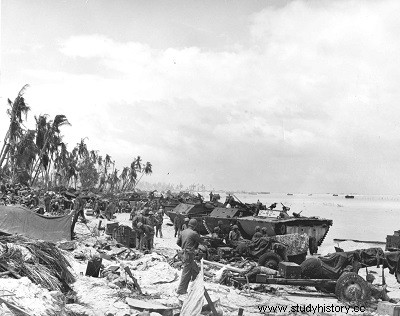
After the hard-won occupation of Tarawa, the state Admiral Nimitz's major was able to proceed immediately to the realization of the second part of his program:the attack on the Marshall Islands, considered as . the only way to advance the war”. The operation took the name of "Flintlock" (rocket gun). The Americans were going to attack Japanese possessions.
Ships and planes were to be assigned to the Central Pacific Fleet which was to take the glorious name of Fifth Fleet at the beginning of 1944. The troops landing craft would constitute the 5th Amphibious Corps. Two divisions had been designated by the committee of joint chiefs of staff. It was the 7th Infantry Division, composed of veterans of the Aleutian campaign and placed under the command of General Corlett, and the 4th Marine Division, a unit trained in the United States and which had no experience of fire, under the orders of General Schmidt. On the other hand, a regiment from the garrison of Samoa, the 22nd Marines, had just left the jungle of the South Pacific; it would become a “regimental combat group” and would constitute the reserve.
The command would be the same as for the Gilbert affair:Spruance, Turner, Hill and Smith were a splendid team with a huge amount of naval experience, especially in the technique of amphibious operations.
One point had also caught their attention:the comparative evaluation of the American and Japanese naval forces revealed that the element of surprise, which had played an essential role in the preparation of operations at the Gilberts, had lost much of its importance when the plan of attack for the Marshalls was set up. Indeed, American aircraft carriers had demonstrated that they were capable of isolating an island battlefield and shielding it from all enemy action. It was therefore decided to increase the time allotted to the amphibious transport phase in the area of the designated objective so as to allow preliminary landings on the adjacent small islands. Thus, the artillery deposited on the ground on the first conquered shore could support the main assault. Another lesson had been learned from the battle of the Gilberts. The duration of naval bombardment could be shortened and ships could concentrate their fire on selected targets instead of spraying an entire area a priori, which had little effect on the deeply entrenched Japanese.
Thanks to improved means of transmission on board the new command ships (amphibious command ships), it would be possible to considerably improve the coordination of air support, the firing of ships and the maneuver of landing craft. Similarly, craft equipped with cannons (landing crafts, infantry guns, .LCl/G) were to appear and take the lead in the assault waves, holding the beaches under the powerful fire of their rapid-fire guns and their rocket launchers. To cross the barrier of coral reefs that surrounds the islands, we would be able to have an increased number of amphibious tracked vehicles (LVT) for the transport of men and, also, the same vehicles, armored (armoured, LVT/A ) to form the first assault wave on each of the main objectives. Finally, the 7th Division was to use in large numbers the famous DUKWs, these amphibious trucks capable of transporting their cargo directly from the ships to the unloading points inland.
However, in the rear guard, under the orders of El Madani, the men had heard the shots. A panting camellia announced to them the massacre of the Tua regs. Without wasting a moment, El Madar hit the camels with his butts to make them turn back. A band of Tuaregs mounted on mehara, seeing their prey
